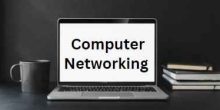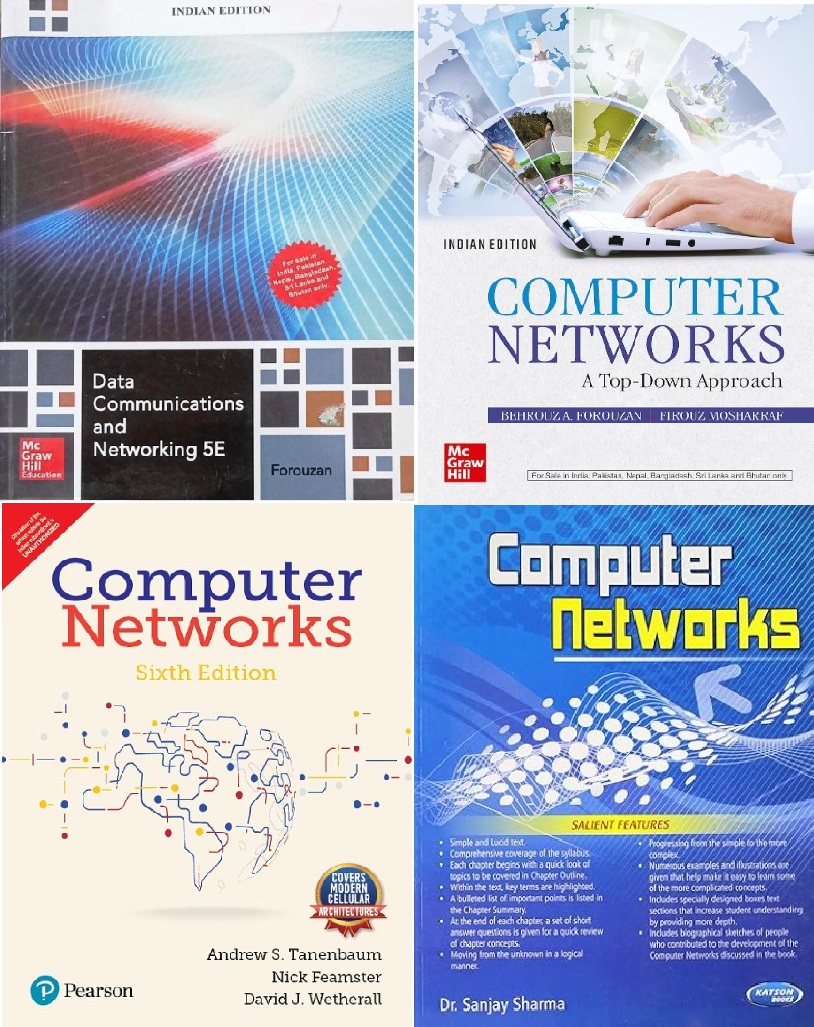Unit 1
Introduction to Data Communication Definition: Effectiveness, Basic Communication Components. Network Architecture Definition, History, Criteria, Goals and Applications of Networks, Categories of networks, Organization of the Internet, ISP, Protocols and standards, The OSI reference model, TCP/IP protocol suite, Network devices and components. Network topology design, Types of connections.
Q141 – A central computer surrounded by one or more satellite computers is called a
Bus network
Star network
Ring network
All of the above
Ans – (2)
Explanation –
In a star network, a central computer (often called a hub or switch) is surrounded by one or more satellite computers. Each satellite computer is connected to the central hub, forming a star-like structure.
Q142 – Common LAN topologies are
Bus and ring
Mesh and Ring
Star
Both a and c
Ans – (4)
Explanation –
Common LAN (Local Area Network) topologies include bus and star configurations. These are widely used in network setups
Bus – Devices are connected in a linear fashion to a single backbone cable. It’s a straightforward design but can lead to performance issues with heavy traffic.
Star – Devices are connected to a central hub or switch, which manages and directs traffic. It’s more scalable and efficient than a bus topology.
Q143 – Difficult reconnection and fault isolation are the disadvantages of
Star topology
Mesh topology
Ring topology
Bus topology
Ans – (4)
Explanation –
In a Bus topology, one of the major drawbacks is the difficulty in reconnecting devices and isolating faults when issues arise.
Imagine a scenario where all devices in your network are connected to a single central cable, which serves as the backbone of your communication system. If this cable becomes damaged or disconnected, resolving the problem isn’t as straightforward as just plugging it back in.
It often requires taking the entire network offline while technicians work to repair or replace the damaged section, causing disruption to everyone connected to the network.
Q144 – The connection of the telephone regional office is the practical example of
Ring
Hybrid
Mesh
Bus
Ans – (3)
Explanation –
In a mesh network topology, every node (such as a regional telephone office) is directly connected to every other node. This creates a robust and redundant network where multiple paths exist for data to travel between nodes.
This redundancy ensures reliability and fault tolerance, making mesh topology suitable for critical communication networks like telephone systems where continuous connectivity is essential. Therefore, the connection of the telephone regional office is a practical example of a mesh topology.
Q145 – ‘Jitter’ refers to-
Errorless delivery
Variation in the packet arrival time
Timely delivery of message
None of the mentioned
Ans – (2)
Explanation –
Jitter refers to the variation in the arrival time of packets in a network. It typically occurs due to network congestion, routing changes, or varying delays in packet transmission.
Jitter can affect the quality of real-time applications like voice over IP (VoIP) or video conferencing, where consistent packet arrival times are crucial for smooth playback or communication.
Q146 – How many lines are required for the bus topology?
N(N-1)/2
N
N+1
None of the mentioned
Ans – (3)
Explanation –
In a bus topology, where all devices are connected to a single central cable (bus), N lines are required.
Here, N represents the number of devices or nodes in the network, each connected directly to the central bus.
Plus 1 bus line that is the backbone of the bus. So, total N + 1 lines are required.
Q147 – A list of protocols used is known as –
Protocol access
Protocol stack
Permutation stack
None of the mentioned
Ans – (2)
Explanation –
A list of protocols used is known as a protocol stack. It refers to a set of protocols that work together in layers to enable communication between devices or systems in a network. Each layer in the protocol stack handles specific aspects of the communication process, such as addressing, error detection, data formatting, and transmission.
Examples of protocol stacks include the TCP/IP protocol stack used in the Internet and the OSI model (Open Systems Interconnection model) used as a conceptual framework for understanding network protocols.
Q148 – In order to prevent a fast sender from swamping a slow receiver with data, feedback is often used. This process is known as-
Flow control
Multiplexing
Congestion
None of the mentioned
Ans – (1)
Explanation –
Flow control is the process of regulating the flow of data between a fast sender and a slow receiver in order to prevent the sender from overwhelming the receiver with data.
Feedback mechanisms are used to achieve flow control by allowing the receiver to signal the sender about its readiness to receive data or to slow down the transmission rate when necessary.
Q149 – IEEE 802.8 is/was –
IBM Token Bus
Integrated Services LAN
Wireless LAN and Mesh
Fiber Optic TAG
Ans – (4)
Explanation –
IEEE 802.8 was a TAG (Technical Advisory Group) within the IEEE 802 LAN/MAN Standards Committee that focused on standards related to fiber optic communication technologies. It provided recommendations and guidelines for the use of fiber optic cables in local area networks (LANs) and metropolitan area networks (MANs).
Q150 – Which of the following was the IBM Token bus?
IEEE 802.10
IEEE 802.11
IEEE 802.1
IEEE 802.4
Ans – (4)
Explanation –
IEEE 802.4 defines the Token Bus access method, which was developed by IBM and used in early LAN implementations.
In Token Bus networks, a token (a special control message) is passed around the network sequentially, allowing devices to transmit data when they possess the token. This method ensures orderly communication and prevents data collisions in the network.
Q151 – A device which is used to boost the signal between two cable segments or wireless access points is
Booster
Repeater
Switch
Router
Ans – (2)
Explanation –
A repeater is a device used to amplify or regenerate signals between two cable segments or wireless access points in a network.
Its primary function is to extend the reach or coverage area of the network by amplifying weak signals and passing them along the network path. Repeaters are commonly used in both wired (Ethernet) and wireless networks to ensure that data signals can travel longer distances without degradation.
Q152 – A device that helps prevent congestion and data collisions –
Switch
Hub
Gateway
Proxy Server
Ans – (1)
Explanation –
A switch is a device that helps prevent congestion and data collisions in a network. It operates at the Data Link Layer (Layer 2) of the OSI model and uses MAC addresses to forward data only to the specific device for which the data is intended.
This eliminates the risk of data collisions that can occur in networks using hubs (which operate at the Physical Layer) where all devices share the same network segment and can potentially transmit data simultaneously.
Q153 – Computer network topology which uses routers is
Bus
Ring
Mesh
Tree
Ans – (3)
Explanation –
A mesh topology is a computer network topology that uses routers extensively. In a mesh network, each device (often including routers) is connected to every other device directly.
This creates multiple paths for data to travel through the network, providing redundancy and resilience against network failures. Routers in a mesh topology help in routing data between different nodes efficiently, ensuring reliable communication across the network.
Q154 – Choose the correct IEEE standards used to manage various computer networks.
IEEE 802.1 = Network Management standards, IEEE 802.2 = General Data Link Layer standards
IEEE 802.3 = MAC layer protocols for a BUS network with CSMA/CD, IEEE 802.4 = MAC layer protocols for a BUS network with Token passing feature
IEEE 802.5 = MAC layer protocols for a Token RING network, IEEE 802.6 = Standards to operate a MAN (Metropolitan Area Network)
All of the above
Ans – (4)
Q155 – What is the other name for an Ethernet network?
WAN
Mesh Network
DIX
DIG
Ans – (3)
Explanation –
Ethernet networks are also commonly referred to as DIX networks. This term originates from the collaboration between Digital Equipment Corporation (DEC), Intel, and Xerox (DIX) that led to the development of Ethernet as a standard networking technology.
Q156 – An Ethernet Jack is ___.
RJ11
RJ14
RJ45
None of the above
Ans – (3)
Explanation –
An RJ45 connector is commonly used for Ethernet connections.
It has eight pins and is larger than an RJ11 or RJ14 connector, which are typically used for telephone connections.
RJ45 connectors are used with Cat5, Cat5e, Cat6, and Cat6a twisted pair cables to connect devices such as computers, routers, switches, and other network equipment in Ethernet networks.
Q157 – The wireless LAN specification is defined by IEEE, called, _______which covers the data link and physical layer
IEEE 802.2
IEEE 802.11
IEEE 802.3
IEEE 802.5
Ans – (2)
Explanation –
IEEE 802.11 is a set of standards that define wireless LAN (WLAN) communication. It includes many variations such as 802.11a, 802.11b, 802.11g, 802.11n, 802.11ac, and more, each offering different speeds and capabilities.
802.11a: Operates at 5 GHz, offers speeds up to 54 Mbps.
802.11b: Operates at 2.4 GHz, offers speeds up to 11 Mbps.
802.11g: Operates at 2.4 GHz, offers speeds up to 54 Mbps, compatible with 802.11b.
802.11n: Operates at both 2.4 GHz and 5 GHz, offers speeds up to 600 Mbps, uses multiple antennas (MIMO).
802.11ac: Operates at 5 GHz, offers speeds up to several Gbps, also uses MIMO and other advanced technologies.
Q158 – __________ uses two pairs of twisted-pair cable.
100Base-TX
100Base-FX
100Base-T4
None of the above
Ans – (1)
Explanation –
100Base-TX is part of the Fast Ethernet standard. It uses two pairs of twisted-pair cable (Category 5 or higher) to achieve 100 Mbps speeds. One pair is used for transmitting data, and the other pair is used for receiving data.
Q159 – _________ uses two fiber-optic cables.
100Base-TX
100Base-FX
100Base-T4
None of the above
Ans – (2)
Explanation –
100Base-FX uses two fiber-optic cables, one for transmitting and one for receiving, to achieve 100 Mbps speeds.
Q160 – The ISDN Internetworking Equipment devices are
Terminal Adapters(TAs)
ISDN Bridges
ISDN Routers
All of these
Ans – (4)
Explanation –
ISDN (Integrated Services Digital Network) Internetworking Equipment encompasses various devices that facilitate the connection of ISDN networks to other types of networks, such as the internet or other digital networks.
Terminal Adapters (TAs) – Devices that allow non-ISDN equipment, such as computers or routers, to connect to an ISDN network.
ISDN Bridges – Devices that connect two or more ISDN networks together, typically for extending coverage or connecting different ISDN services.
ISDN Routers – Devices that manage data traffic between an ISDN network and other networks, such as the internet, by directing data packets to their destination.



